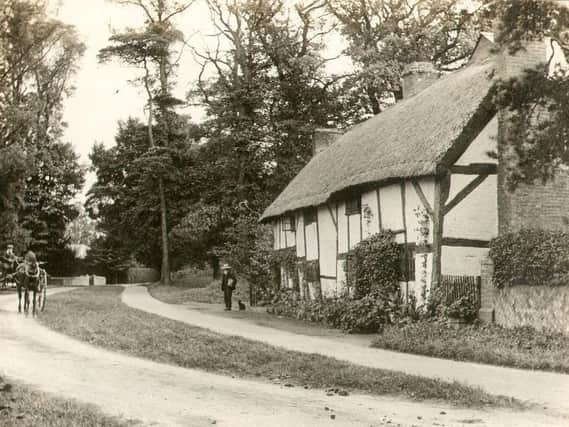Former Advertiser reporter remembers Gert and Daisy, two proud Rugby porkers who lived like royalty


As many Rugby people will remember, the clock and watch trade was once a major industry in the nearby city of Coventry.
But like so many British enterprises, it was driven into extinction by cheap foreign competition, mainly from Switzerland and America.
Advertisement
Hide AdAdvertisement
Hide AdOf course, this would become a familiar story, repeated time and again with other businesses that had once put the ‘Great’ in Britain.
My maternal grandfather was a Coventry watchmaker, and when the orders finally dried up, he left Godiva’s city, and started a poultry farm at Stretton-on-Dunsmore.
Unfortunately, the enterprise ended in disaster. Disease decimated his flock… and that was that. He died not long after, and this being the 1930s, his dependents were thrown into poverty, as was so often the case in those days when there was the loss of a breadwinner.
Years later, when my family had moved to Churchover, we started keeping livestock again. There were several hovels at the end of the garden at Woodbine Cottage, and these were soon put to good use.
Advertisement
Hide AdAdvertisement
Hide AdThe first inhabitants were a couple of pigs, Gert and Daisy. When I refer to ‘hovels’, I should perhaps say ‘hotels’, because they had a pleasant - if an admittedly rather short stay - at this luxurious accommodation.
Gert and Daisy had the most wonderful diet, subject to seasonal availability. My sister and I would collect all manner of porcine delicacies for our guests, everything that the once-abundant hedgerows around Churchover could provide.
There was dock, plaintains broad and narrow leafed, keck (cow parsley to those unfortunate enough to not have been born in Warwickshire), clover and the appropriately named sow thistle.
There was many a time that their deliriously joyful chomping could be heard drifting over the potato patch, the eventual peelings from which would also soon end up on Gert and Daisy’s daily dinner plate.
Advertisement
Hide AdAdvertisement
Hide AdBut one day, the end came. A cattle truck from Rugby arrived, and these two sisters-in-muck were prodded aboard. There was many a tear shed, but to no avail. Gert and Daisy would not be returning to their five-star hotel.
Once the pigs had left, the hovels were quickly converted into hen pens, and the first arrivals settled down in their whitewashed boxes to lay eggs, and afterwards enjoy a bit of scratching in the layer of peat that now covered the floor of the previous residents’ abode.
Once again, sentiment didn’t enter the equation once the hens went off the lay. My mother, clearly remembering her days at the poultry farm in Stretton, could dispatch a chicken in a second.
Cradle the bird, grab it behind the head, a downwards thrust and twist… and there was Sunday dinner.
Advertisement
Hide AdAdvertisement
Hide AdAll that was then required would be the removal of the feathers and the ‘drawing’. I can still remember the awful smell, not that this would put me off the succulent cooked meat that would turn up on my plate a few hours later.
Those days seem such a long time ago now. Years ago, many people in the Rugby area kept hens, and in the 1950s there might also be a few who still had pigs in the backyard.
In fact, go back in time even further, and you would find that most working class folk kept a pig. Fattened up during the year, the butcher would pay a visit in the autumn, and the meat would be slow-cured all ready for Christmas.
There were a couple of outhouses at Woodbine Cottage and one of them had pig chains hanging from the wall. The floor was coated with an inch of black, congealed pigs’ blood which felt ‘springy’ when you trod on it.
Advertisement
Hide AdAdvertisement
Hide AdAll this must sound quite gruesome to the modern reader. But in those days, people were much closer to the food that they ate, acknowledging the link between the living animal or plant, and its progress to the table.
Today’s children would certainly be upset to see an animal meet its end, just as we had been, weeping buckets when Gert and Daisy began their final journey.
But how many of today’s youngsters tuck into burgers and kebabs without a single thought for where the food originated? This is not their fault, of course, because they cannot have any knowledge of the factory farming that provides so much of the protein that we now eat.
I shudder to think how my grandchildren would react if they saw their mother wring a chicken’s neck, probably just as their mother would also have reacted had she witnessed the first stage of food preparation in times gone by.
Advertisement
Hide AdAdvertisement
Hide AdNowadays, a supermarket is never less than a mile or two away. We drive into the car park, fill the trolley without a single thought of how all that food was created, and then leave for home. Job done.
So much has changed in my lifetime. Gone are many of the hedgerows that provided free food for our animals, gone are the hovels that once lay at the bottoms of so many people’s gardens.
And long gone too are Gert and Daisy, two proud and pristine porkers who once lived like royalty at our home in Churchover.
John Phillpott writes about his 1950s country childhood in Beef Cubes and Burdock, published by Austin Macauley.